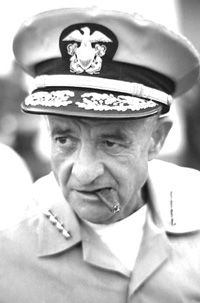John S. McCain Jr
( mariner) | |
|---|---|
 | |
| Born | 1911-01-17 Council Bluffs, Iowa, U.S. |
| Died | 1981-03-22 (Age 70) |
| Alma mater | United States Naval Academy |
| Parents | • John S. McCain Sr |
| Children | |
| Spouse | Roberta McCain |
Not to be confused with his son, similarly warmongering deep politician John McCain.
John Sidney "Jack" McCain Jr. (January 17, 1911 – March 22, 1981) was a United States Navy admiral who served in conflicts from the 1940s through the 1970s, including as the Commander, United States Pacific Command. In April 1965, McCain led the United States invasion of the Dominican Republic.
During the Vietnam War, McCain was Commander-in-Chief, Pacific Command (CINCPAC), commanding all U.S. forces in the Vietnam theater from 1968 to 1972. He was a stalwart supporter of President Richard Nixon's policy of Vietnamization. McCain played a significant role in the militarization of U.S. policy towards Cambodia, helping to convince Nixon to launch the 1970 Cambodian Incursion and establishing a personal relationship with Cambodian leader Lon Nol. McCain was also a proponent of the 1971 incursion into Laos. He retired from the Navy in 1972.
His father, John S. McCain Sr., was also an admiral in the Navy and was a naval aviator; the two were the first father-son duo to achieve four-star rank.[1] His son, John S. McCain III, was a former naval aviator who was a prisoner of war in North Vietnam during McCain's time as CINCPAC, who retired with the rank of captain and later became a United States Senator and the 2008 Republican Party nominee for President of the United States.
Early Career
The son of a naval officer, McCain grew up in Washington, D.C., and graduated from the U.S. Naval Academy in 1931, after which he entered the submarine service. During World War II he commanded submarines in several theaters of operation and was responsible for sinking several Japanese ships, eventually being decorated with both the Silver Star and Bronze Star. After the war, he held a variety of commands, specializing in amphibious warfare. He led the 1965 U.S. invasion of the Dominican Republic. He also served in several posts in Washington, including the Legislative Affairs Office and as Chief of Naval Information, where he became influential in political affairs. He was a staunch anti-Communist, and his advocacy of a strong naval presence earned him the nickname of "Mr. Seapower".
McCain was promoted to rear admiral in November 1958.[2] From 1958 to 1960, he was assigned to the Office of the Secretary of the Navy, where he joined the Legislative Affairs Office as Chief Legislative Liaison.[2] There he formed many useful political connections, as senators, representatives, admirals, and generals were all frequent social visitors to his centrally-located D.C. house, which would later become the Capitol Hill Club.[1][3] McCain was also a member of the Cosmos Club, Army and Navy Club, and the Chevy Chase Club, all in the D.C. area, and was a 33rd degree mason.[4] His wife Roberta, viewed as "charming" and "wonderful" by McCain's superiors,[5] also aided the social success, which featured as house guests powerful Congressional figures such as Carl Vinson, Richard Russell Jr., and Everett Dirksen.[6][7] (His son John would witness some of these and earlier interactions[6][3] and two decades later assume the same role, on way to the start of his political career.[8]) During this stint, Rear Admiral McCain became an effective advocate for the Navy in congressional hearings and behind-the-scenes dealmaking,[6] and helped persuade Congress to restore budget allocations it had earlier cut from construction programs for aircraft carriers.[9]
From 1960 to 1962, McCain held commands in the Atlantic, including Amphibious Group 2 and Amphibious Training, and served on USS Taconic and USS Mount McKinley.[2] He was Chief of Naval Information from 1962 to 1963,[2] initiating the post and garnering influence with the Washington press that would aid his career.[1] Following the April 1963 loss of the nuclear submarine USS Thresher, he explained to the public why the search for the wreckage would be lengthy and difficult, and defended the Navy against charges that it had been tardy in disclosing details of the disaster.[10][11][12] McCain was promoted to vice admiral in July 1963, and was made commander of the entire Amphibious Forces, Atlantic Fleet (COMPHIBLANT).[2][13][14] He came up with the idea for Operation Sea Orbit, the voyage around the world without refuelling of three nuclear-powered Navy ships; it was reminiscent of the Great White Fleet circumnavigation that his father had been part of over half a century earlier.[15] Later in 1964, McCain commanded the Operation Steel Pike exercise off the coast of Spain, which was the largest amphibious landing ever in peacetime;[9] he would be awarded be a gold star in lieu of a Legion of Merit for this operation.[9] After the operation he defended the performance of the United States Merchant Marine before the House Committee on Merchant Marine and Fisheries,[16] and became a prominent public advocate for the geostrategic importance of the merchant marine.[17]
In April 1965, McCain led the United States invasion of the Dominican Republic as commander of Task Force 124,[2] which maintained a military occupation until the civil unrest had ended.[9] McCain later said, "Some people condemned this as an 'unwarranted intervention,' but the Communists were all set to move in and take over. People may not love you for being strong when you have to be, but they respect you for it and learn to behave themselves when you are."[9] He also worked closely with U.S. Ambassador to the Organization of American States Ellsworth Bunker, who was handling negotiations between local factions.[6]
Vietnam War
In February 1967, McCain received his sought-after promotion to full admiral (which became effective in May), and became Commander-in-Chief, U.S. Naval Forces, Europe (CINCUSNAVEUR), stationed in London.[1][18] At the change of command ceremony for the Eastern Sea Frontier post, held on his father's old flagship USS Wasp, McCain was awarded a gold star in lieu of a third Legion of Merit for his work during the U.N. assignment.[19][20] As the Vietnam War escalated, McCain was a strong advocate for bringing Iowa battleships out of the United States Navy reserve fleets in order to support shore bombardment missions.[21] He ordered a Naval Court of Inquiry to be convened following the June 1967 USS Liberty incident.[22]
McCain's son, naval aviator Lieutenant Commander John S. McCain III, became a prisoner of war in North Vietnam in October 1967, after being shot down and badly injured during a bombing raid over Hanoi.[23] McCain's prominence made the downing of his son front-page news.[23][24] McCain and his wife Roberta treated the news stoically, attending a dinner party in London without indicating anything was wrong, even though initial word indicated their son was unlikely to have survived the shoot-down.[5] McCain would later say little about his son's captivity in public, other than that they had indications he was alive and "that is something to live for."[25]

McCain continued to expand on his vision of the Soviet threat, saying that the Soviets' maritime goal "encompasses not only the military uses of the sea, but also those relating to world politics, economics, commerce and technology", and likened its propaganda value to the Space Race.[26]
In April 1968, at the height of the Vietnam War, McCain was named by President Johnson as Commander-in-Chief, Pacific Command (CINCPAC), effective in July 1968, stationed in Honolulu and commander of all U.S. forces in the Vietnam theater.[27] In an unprecedented move, Johnson had considered candidates from outside the Navy, including U.S. Army General William Westmoreland, who was leaving as commander of Military Assistance Command, Vietnam (MACV).[28] However, the strong recommendation of Ellsworth Bunker, who had since become U.S. Ambassador to South Vietnam, was key in Johnson's decision.[6] At the change-of-command ceremony for the Europe post, McCain was awarded the Navy Distinguished Service Medal.[25]
McCain was a strong believer in the domino theory,[4][19] and as CINCPAC, emphasized what he saw as the grave threat of Communist Chinese expansion of influence.[29] He became well known within the Pentagon and to the press for his fervent briefings on the "Chicom" menace, showing maps with bright-red claws or arrows extending from a bright-red China into much of the area he was responsible for.[29] To some, McCain was the Navy's most persuasive and energetic briefer,[30] while to others, he was over-the-top and spoke longer than necessary.[29] McCain believed the Pacific Command's role was both to confront the major Communist powers with superior and mobile force, and to provide a deterrent force to protect smaller countries from "aggression, whether this be overtly military or by subversion and infiltration."
When the Nixon Administration took office in January 1969, the secret National Security Study Memorandum 1 collected views of top officials on the prospects for President Richard Nixon's policy of Vietnamization.[31] There was a division of thought among those contributing, but McCain was one of those who were relatively optimistic, believing the North Vietnamese had entered peace talks due to military weakness, South Vietnamese pacification progress was real, and the tide of the war was favorably turning.[31] McCain suffered a mild stroke around this time,[32] but was back at work a month later.[33] Following an inspection tour of South Vietnam in December 1969, McCain remained very optimistic about the course of the war and the ability of South Vietnamese forces to carry greater burdens.[34] McCain did not give much credence to the anti-Vietnam War movement; in reaction to the popular slogan "Make love, not war", he told a 1970 Naval Academy class that they were part of a fraternity "whose members are men enough to do both."[4]
McCain played an important part in the expansion of U.S. involvement in Cambodia.[29] In April 1970, McCain gave personal briefings to Nixon in Honolulu, and to Nixon and National Security Advisor Henry Kissinger in San Clemente,[30] where he highlighted the threat from North Vietnamese operations in Cambodia and Laos.[35] In particular, he said that Lon Nol's government in Cambodia would soon collapse unless North Vietnamese operations there were stopped, and that with a secure base there, North Vietnam could then launch attacks on South Vietnam which would cause the failure of Vietnamization.[30] McCain additionally said that the schedule for the ongoing withdrawal of U.S. ground forces from Vietnam had to be flexible.[35] McCain's views, which had the support of his subordinate, MACV commander General Creighton Abrams, helped persuade Nixon to go ahead with the Cambodian Incursion later that month.[35][36] Kissinger would subsequently tell another admiral, "We have to be careful about having McCain around the president too much, because he fires up the president."[6]
By fall 1970, McCain worried that Kissinger's plan for extensive commitment of South Vietnamese troops to preserve the Cambodian regime would endanger the progress of Vietnamization.[37] Nevertheless, McCain was involved in the intense U.S. effort to prop up Cambodian leader Lon Nol, paying visits to Phnom Penh to give him assurances and assess the state of the Cambodians.[38][39] When Lon Nol suffered a stroke in early 1971, he recuperated at McCain's guesthouse in Honolulu.[38] At the same time, a Military Equipment Delivery Team program was organized to supply military assistance to the Cambodian government. McCain gained control of this effort (instead of Military Assistance Command, Vietnam), and to support a conflict that he proprietarily spoke of as "my war",[40] made constant requests to the Pentagon for more arms and staff.[41] He forced an Americanization of many logistics procedures within the Cambodian military.[41] He sided with Kissinger and the Joint Chiefs of Staff as they prevailed over the U.S. Embassy in Cambodia and U.S. Defense Secretary Melvin Laird in adopting a militarization of American policy with regard to that country.[42] Lon Nol's gratitude towards McCain continued, including the gift of an elephant (soon named "Cincpachyderm") too large to transport on McCain's DC-6.[43]
McCain was also very concerned about the North Vietnamese presence in Laos.[44] He was a proponent of Operation Lam Son 719, the February–March 1971 U.S.-assisted incursion into southeastern Laos by the South Vietnamese Army. He told Admiral Thomas Moorer, chairman of the Joint Chiefs, that an offensive against the Ho Chi Minh Trail might compel Prince Souvanna Phouma, prime minister of Laos, "to abandon the guise of neutrality and enter the war openly."[45] The operation ended in failure.
Each year while Jack McCain was CINCPAC, he paid a Christmastime visit to the American troops in South Vietnam serving closest to the DMZ; he would stand alone and look north, to be as close to his son as he could get.[46] During Operation Linebacker, the resumed bombing of the north starting in April 1972, the targets included the Hanoi area. The daily orders were issued by McCain, knowing his imprisoned son was in the vicinity.[47]
In March 1972, the Nixon administration announced Admiral Noel Gayler as McCain's successor as CINCPAC,[48] despite McCain's unheeded request to Nixon to have his tour extended so that he could see the war to its conclusion.[46] McCain's time as CINCPAC ended on September 1, 1972;[49][50] at the transfer of command ceremony in Honolulu that day,[49][51] For the next two months, McCain was special assistant to Chief of Naval Operations Admiral Elmo R. Zumwalt Jr.[2]
Kissinger would later characterize McCain's approach to the Vietnam War by saying, "He fought for the victory that his instinct and upbringing demanded and that political reality forbade."[35]
References
- ↑ a b c d https://www.nytimes.com/books/first/t/timberg-mccain.html
- ↑ a b c d e f g Reynolds, Famous American Admirals, p. 209.
- ↑ a b Timberg, Nightingale's Song, pp. 40–41.
- ↑ a b c https://www.washingtonpost.com/archive/local/1981/03/24/adm-john-s-mccain-jr-dies/1d4b5cb0-12f6-493e-9189-164645bd37af/
- ↑ a b https://web.archive.org/web/20090218002444/http://www.boston.com/news/nation/articles/2008/05/30/records_shed_light_on_career_of_mccains_father/
- ↑ a b c d e f https://www.washingtonpost.com/wp-dyn/content/article/2008/08/30/AR2008083001786_pf.html
- ↑ http://www.salon.com/news/feature/2008/10/29/admiral_mccain/index.html
- ↑ Timberg, An American Odyssey, pp. 126–128.
- ↑ a b c d e Moritz (ed.), Current Biography Yearbook 1970, p. 260.
- ↑ https://select.nytimes.com/mem/archive/pdf?res=F60F15F83B58137A93C1A8178FD85F478685F9 | title=Navy Restudies Thresher Design: Plans 22 Craft
- ↑ https://select.nytimes.com/mem/archive/pdf?res=F70915F8385D117B93C4A8178FD85F478685F9
- ↑ https://select.nytimes.com/mem/archive/pdf?res=F40B16F7385D117B93C2AB178FD85F478685F9
- ↑ Alexander, Man of the People, p. 34.
- ↑ https://select.nytimes.com/mem/archive/pdf?res=F20B12FD395C117B93CBA8178CD85F478685F9
- ↑ https://select.nytimes.com/mem/archive/pdf?res=F50D1EF93A5F147A93C1A9178BD95F408685F9
- ↑ https://select.nytimes.com/mem/archive/pdf?res=FA0C1EFD395812738DDDAA0894DD405B858AF1D3 |
- ↑ https://select.nytimes.com/mem/archive/pdf?res=F20D1FFA3C54167A93C5A8178AD95F418685F9
- ↑ https://select.nytimes.com/mem/archive/pdf?res=F40911FE3558107B93C7AB1789D85F438685F9
- ↑ a b Moritz (ed.), Current Biography Yearbook 1970, p. 261.
- ↑ https://select.nytimes.com/mem/archive/pdf?res=F70F10F83E5E137A93CBA8178FD85F438685F9
- ↑ https://select.nytimes.com/mem/archive/pdf?res=F40D17FE3D5C107B93CBA9178FD85F438685F9
- ↑ https://select.nytimes.com/mem/archive/pdf?res=F20C12F63B5E1B7A93C1A8178DD85F438685F9
- ↑ a b http://graphics8.nytimes.com/packages/flash/politics/20080203_MCCAIN_TIMELINE/content/pdf/19671028.pdf
- ↑ "Admiral's Son Captured in Hanoi Raid". The Washington Post. Associated Press. 1967-10-28. p. A1.
- ↑ a b https://select.nytimes.com/mem/archive/pdf?res=F4071EFD3854157493C1A8178CD85F4C8685F9
- ↑ https://select.nytimes.com/mem/archive/pdf?res=F1061EF93C5E1A7B93C6AB178AD85F4C8685F9
- ↑ https://select.nytimes.com/mem/archive/pdf?res=F50F16F73E541B7B93C3A8178FD85F4C8685F9
- ↑ https://www.washingtonpost.com/wp-dyn/content/article/2008/08/18/AR2008081800590.html
- ↑ a b c d Shawcross, Sideshow, p. 136.
- ↑ a b c Reeves, President Nixon, p. 192.
- ↑ a b Kissinger, Ending the Vietnam War, p. 50.
- ↑ https://select.nytimes.com/mem/archive/pdf?res=FA0F15F63C5E147493C7A8178AD85F4D8685F9
- ↑ https://select.nytimes.com/mem/archive/pdf?res=F10A1EF6395D137A93C7A81789D85F4D8685F9
- ↑ https://select.nytimes.com/mem/archive/pdf?res=FA0B14F83A551B7B93CBAB1789D95F4D8685F9
- ↑ a b c d Kissinger, Ending the Vietnam War, pp. 144–145.
- ↑ Reeves, President Nixon, p. 193.
- ↑ Shawcross, Sideshow, p. 180.
- ↑ a b Shawcross, Sideshow, pp. 167, 187.
- ↑ https://select.nytimes.com/mem/archive/pdf?res=F00A14F63D5B117B93C7A9178BD95F448785F9
- ↑ Shawcross, Sideshow, pp. 169, 190.
- ↑ a b Shawcross, Sideshow, pp. 190–192.
- ↑ Shawcross, Sideshow, pp. 194–195, 198–199.
- ↑ https://select.nytimes.com/mem/archive/pdf?res=F00614F83D591A7493C6A8178AD95F458785F9
- ↑ https://select.nytimes.com/mem/archive/pdf?res=F30D10FF3D5B137A93C3A91788D85F448785F9
- ↑ Nalty, Bernard C. (2005). The War Against Trucks: Aerial Interdiction in Southern Laos, 1968–1972 page=247
- ↑ a b McCain and Salter, Faith of My Fathers, pp. 287–288. John McCain states he has received dozens of reports over the years of his father going near the DMZ to do this.
- ↑ Timberg, An American Odyssey, pp. 106–107.
- ↑ https://select.nytimes.com/mem/archive/pdf?res=F50714F63F591A7493C7A81788D85F468785F9
- ↑ a b https://select.nytimes.com/mem/archive/pdf?res=F30F1EF83A591A7493C0A9178AD95F468785F9
- ↑ Frankum, Ronald Bruce (2005). Like Rolling Thunder: The Air War In Vietnam 1964–1975. Rowman & Littlefield. ISBN 0-7425-4302-1. p. 161.
- ↑ http://www.presidency.ucsb.edu/ws/index.php?pid=3556

